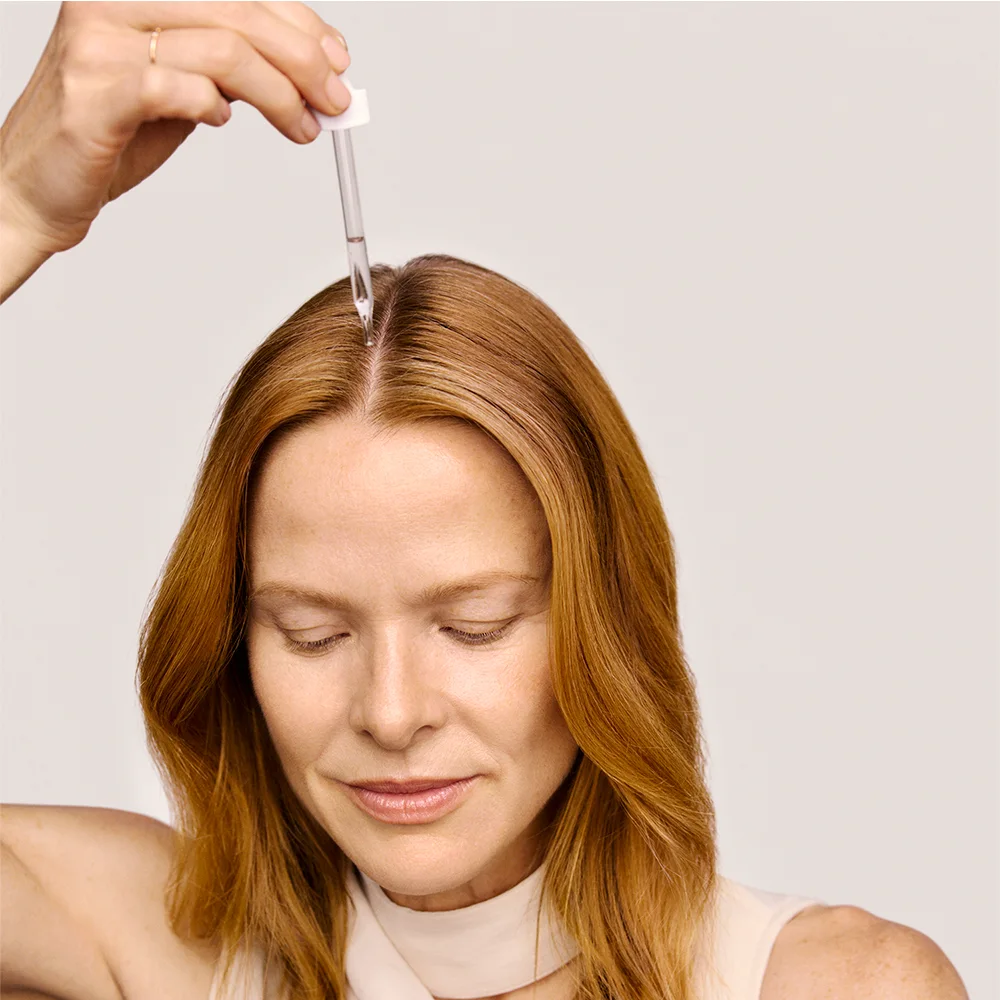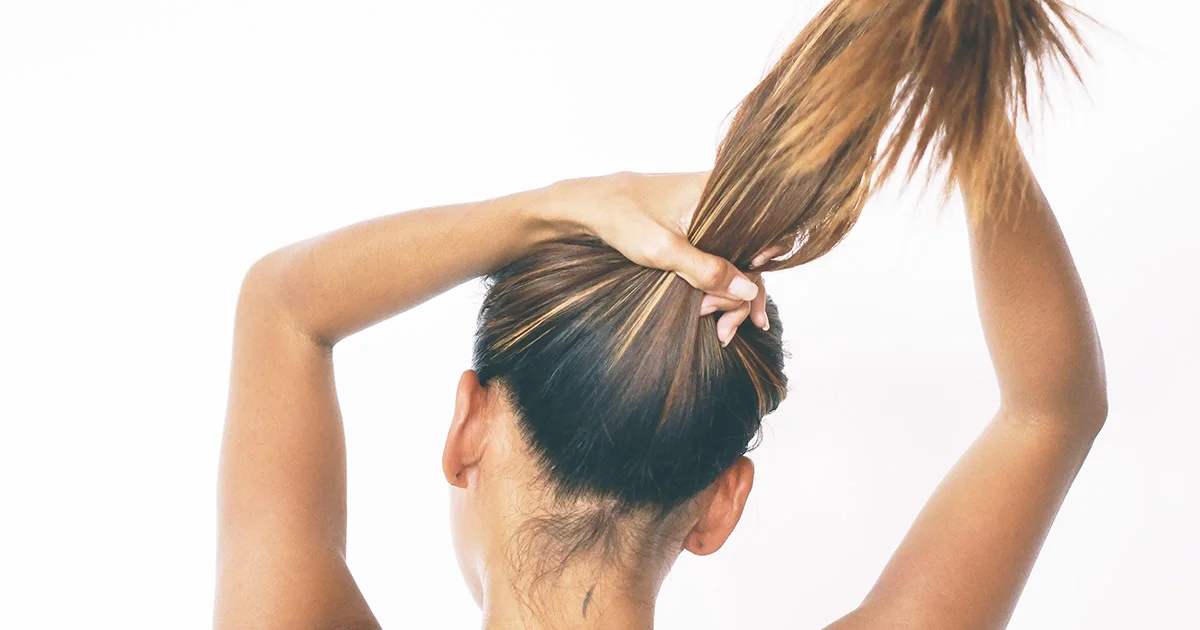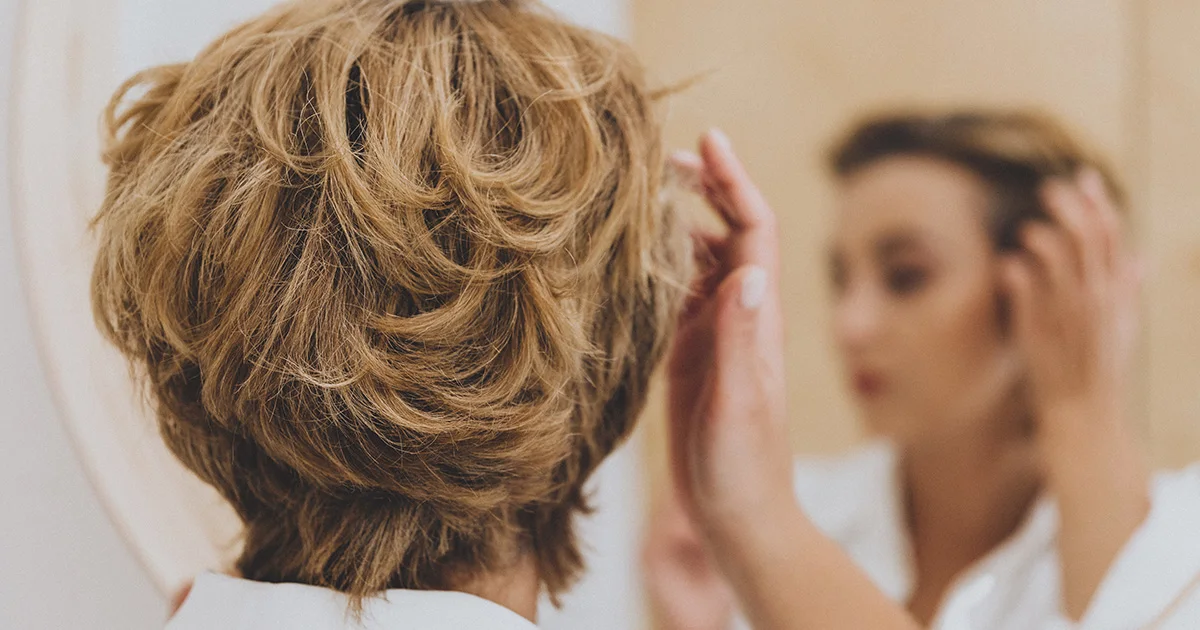Here's what we'll cover
Here's what we'll cover
If you are a woman affected by hair loss or thinning hair, you may be wondering about available treatments, including DHT blockers for women. DHT blockers are a type of anti-androgen medication that can accelerate hair growth, promote healthier hair, and stop hair loss from continuing (Salisbury, 2022).
DHT blockers are not FDA-approved for women with hair loss, though some medications that change DHT’s effects in the body are prescribed off-label for this purpose. Anti-androgen medications have shown promise in women with high androgen levels (Fabbrocini, 2018).
Read on to learn more about DHT blockers for women, including safety and side effects. We will also explore the various causes of hair loss in women, and different evidence-based treatment options for hair loss.
What is a DHT blocker?
Dihydrotestosterone (DHT) is a type of androgen hormone (sex hormones present in both men and women, but in much higher levels in men) that’s responsible for a wide range of processes in the body (Kinter, 2022).
During puberty, DHT is associated with male sex characteristics, such as the development of facial hair, body hair, and prostrate growth. Women with polycystic ovarian syndrome (PCOS) and certain other conditions often have increased levels of DHT. As men get older, elevated DHT levels cause male pattern baldness (also known as androgenic alopecia). DHT’s role in female pattern baldness is less well established, but it’s thought that elevated DHT levels may play a role (Fabbrocini, 2018).
As their name implies, DHT blockers block DHT in the body through various mechanisms, which can promote hair growth by decreasing the types of hair loss associated with elevated DHT.
Finasteride
Finasteride (see Important Safety Information) is a DHT blocker known for reducing hair loss in men. It's approved by the FDA for that purpose and backed up by plenty of research. The research on finasteride use in women is lacking, but some studies and case reports have shown positive results when it comes to increasing hair growth in women (Herskovitz, 2013).
Spironolactone
An anti-androgen and potassium-sparing diuretic, spironolactone reduces total testosterone in the body and blocks androgen receptors. Although not approved to address female pattern hair loss in the US, it’s often used off-label for this purpose. It’s generally dosed at 50–200 mg per day for at least 6 months. Studies have found that spironolactone stops the progression of hair loss in 90% of women, and increases hair density in 30% of women (Chan, 2018).
Cyproterone acetate
This anti-androgen medication works by blocking androgen receptors and reducing testosterone levels. Results of cyproterone for female pattern hair loss are similar to a 200 mg daily dose of spironolactone (Chan, 2018).
DHT blocker side effects in women
Finasteride is considered safe in men but hasn’t been extensively studied in women. Finasteride should be avoided in pregnancy, as it can cause feminization of a male fetus. If you have a history of breast cancer, or if breast cancer runs in your family, you should avoid finasteride (Herskovitz, 2013).
Spironolactone, which blocks androgen sex hormones and encourages hair growth, is considered a safe and effective treatment for female pattern hair loss (Chan, 2018). Since it is a diuretic, spironolactone can affect your kidneys. Be sure to tell your healthcare provider about any underlying conditions you may have, including kidney issues (Patibandla, 2022).
Common side effects of spironolactone include exhaustion and heavy menstrual bleeding, but these symptoms usually improve after about 3 months. Spironolactone is a class D pregnancy medication, which means there may be risks to the fetus if you take this medication while pregnant (Chan, 2018).
It’s particularly important that women using cyproterone acetate avoid it completely when pregnant. That’s because cyproterone acetate is a pregnancy category X medication and has the potential to cause feminization of male fetuses. Common side effects of cyproterone acetate are lowered sex drive, tender breasts, and extra weight gain (Chan, 2018).
What causes hair loss in women?
Female pattern hair loss is more common than you might realize. It affects about 21 million women in the US, and is especially common as women age (Herskovitz, 2013). But the condition affects women of all ages, with 12% of women in their 30s experiencing it, and about 40% of women experiencing hair loss by age 50 (Herskovitz, 2013; Famenini, 2015).
Hair loss in women looks a little different than hair loss in men. Usually, women experience thinning hair, receding hairlines, and a widening hair part. Eventually, the hair near the temples will diminish. As time goes on, more hair thins, until you experience extensive thinning (AAD, 2022).
There are several potential causes of hair loss in women. Most experts believe that androgenetic alopecia is an inherited condition. Age also likely plays a role, with women experiencing more hair thinning and hair loss the closer they get to menopause (AAD, 2022).
Other potential causes of hair loss in women include (Chan, 2018):
Adrenal hyperplasia
Ovarian tumors
Adrenal tumors
Polycystic ovarian syndrome (PCOS)
There is a correlation between female pattern hair loss and certain medical conditions, such as high blood pressure, heart disease, and diabetes. Risk factors for female pattern baldness include age, having a family history of hair loss, smoking, excessive sun exposure, and having high fasting glucose levels (Chan, 2018).
Other options for treating women’s hair loss
DHT blockers aren’t the only treatment options for female pattern hair loss. There are other medications that can be used and treatments to try, as well as natural DHT blockers to consider. Let’s take a look at some effective alternative options out there.
Minoxidil
Also known as Rogaine, minoxidil is a DHT blocker used to treat male pattern hair loss, and is known to be helpful in treating female hair loss as well. The treatment is FDA-approved for women and you can get minoxidil without a prescription. It can take up to a year to see results with minoxidil (AAD, 2022).
Minoxidil has a strong safety record and is FDA-approved for use in women. Side effects of minoxidil include dryness and an itchy, red scalp. Minoxidil should not be used in pregnancy or during breastfeeding (AAD, 2022).
Pumpkin seed oil
A natural DHT blocker, pumpkin seed oil has shown promise in treating male pattern hair loss. One study found that men who used pumpkin seed oil to treat hair loss for 24 weeks saw increases in hair growth. Men using the treatment saw a 40% increase in hair growth, whereas men who were given a placebo only saw a 10% increase (Cho, 2014). Although pumpkin seed oil hasn’t been studied extensively in women for hair loss, it shows some promise as a treatment (Ibrahim, 2021).
Other possible treatments for hair loss in women include (Fabbrocini, 2018):
Light therapy
Prostaglandin analog treatments
Platelet-rich plasma
Vitamin supplements, such as iron, biotin, zinc, B-complex vitamins, vitamin D
Herbals supplements like saw palmetto or marine protein complexes
Many of the non-medical treatments for female hair loss are experimental and there isn’t much research regarding their safety and effectiveness. That’s why it’s important to consult with your healthcare provider before trying any treatment for hair loss.
Losing one’s hair can have significant emotional impacts and can strongly impact self-esteem. The good news is there are many options when it comes to treating female hair loss and you should feel empowered to find one that works for you.
DISCLAIMER
If you have any medical questions or concerns, please talk to your healthcare provider. The articles on Health Guide are underpinned by peer-reviewed research and information drawn from medical societies and governmental agencies. However, they are not a substitute for professional medical advice, diagnosis, or treatment.
American Academy of Dermatology Association (AAD). (2022). Thinning hair and hair loss: could it be female pattern hair loss? Retrieved on Nov. 21, 2022 from https://www.aad.org/public/diseases/hair-loss/types/female-pattern
Chan, L. & Cook, D. K. (2018). Female pattern hair loss. Australian Journal of General Practice, 47 (7). doi:10.31128/AJGP-02-18-4498. Retrieved from https://www1.racgp.org.au/ajgp/2018/july/female-pattern-hair-loss
Cho, Y. H., Lee, S. Y., & Jeong, D. W. (2014). Effect of pumpkin seed oil on hair growth in men with androgenetic alopecia: a randomized, double-blind, placebo-controlled trial. Evidence-Based Complementary and Alternative Medicine, 2014,
doi:10.1155/2014/549721. Retrieved from https://www.ncbi.nlm.nih.gov/pmc/articles/PMC4017725/
Fabbrocini, G., Cantelli, M., Masarà A., et al. (2018). Female pattern hair loss: A clinical, pathophysiologic, and therapeutic review. International Journal of Women’s Dermatology, 4 (4), 203-211. doi:10.1016/j.ijwd.2018.05.001. Retrieved from https://www.ncbi.nlm.nih.gov/pmc/articles/PMC6322157/
Famenini, S., Slaught, C., Duan, L., et al. (2015). Demographics of women with female pattern hair loss and the effectiveness of spironolactone therapy. Journal of the American Academy of Dermatology, 73(4), 705-706 . doi:10.1016/j.jaad.2015.06.063. Retrieved from https://www.jaad.org/article/S0190-9622(15)01878-2/fulltext
Herskovitz, I. & Tosti, A. (2013). Female pattern hair loss. International Journal of Endocrinology and Metabolism, 11 (4), e9860. doi:10.5812/ijem.9860. Retrieved from https://www.ncbi.nlm.nih.gov/pmc/articles/PMC3968982/
Ibrahim, I. M., Hasan, M. S., Elsabaa, K. I., et al. (2021). Pumpkin seed oil vs. minoxidil 5% topical foam for the treatment of female pattern hair loss: A randomized comparative trial. Journal of Cosmetic Dermatology, 20 (9), 2867-2873. doi:10.1111/jocd.13976. Retrieved from https://pubmed.ncbi.nlm.nih.gov/33544448/
Kinter, K. J. & Anekar, A. A. (2022). Biochemistry, dihydrotestosterone. StatPearls . Retrieved on Dec. 23, 2022 from https://www.ncbi.nlm.nih.gov/books/NBK557634/
Patibandla S., Heaton, J., & Kyaw, H. (2022). Spironolactone. StatPearls . Retrieved on Dec. 23, 2022 from https://www.ncbi.nlm.nih.gov/books/NBK554421/
Salisbury, B. H. & Tadi, P. (2022). 5-alpha reductase inhibitors. StatPearls. Retrieved on Dec. 23, 2022 from https://www.ncbi.nlm.nih.gov/books/NBK555930/
Sinclair, R. D. (2017). Female pattern hair loss: a pilot study investigating combination therapy with low-dose oral minoxidil and spironolactone. International Journal of Dermatology, 57 (1), 104-109. doi:10.1111/ijd.13838. Retrieved from https://onlinelibrary.wiley.com/doi/abs/10.1111/ijd.13838










